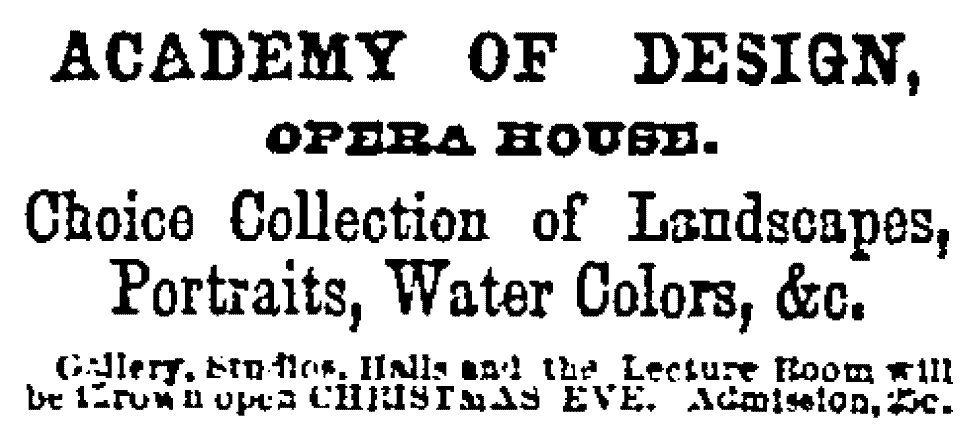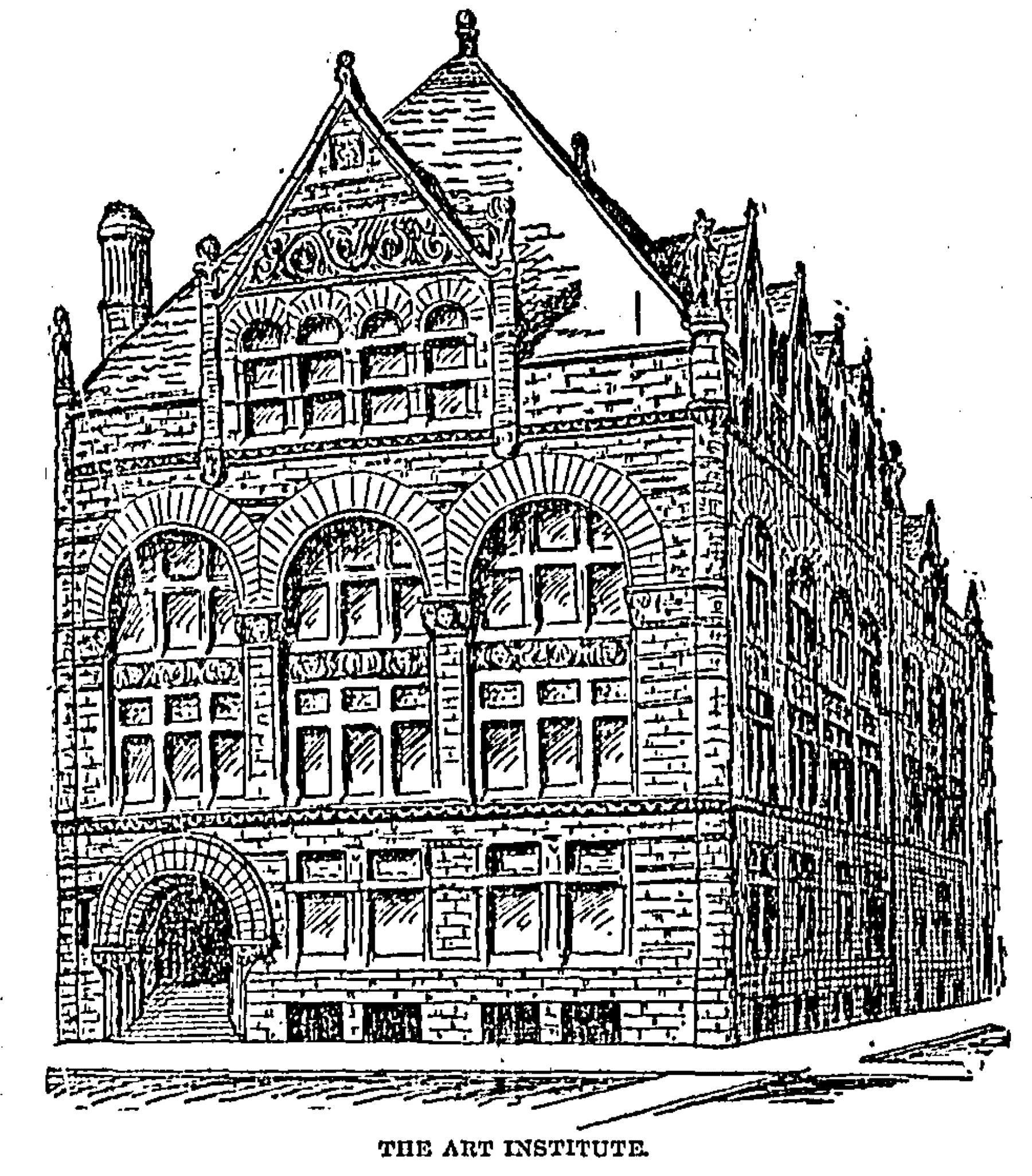The Art Institute of Chicago in Grant Park. Photo by Eric Allix Rogers.
Last month, I wrote about how businessman Aaron Montgomery Ward fought several legal battles to prevent the construction of the Field Museum in the center of Grant Park. But I only briefly explained that in the mid-1890s, when Ward’s lawsuits began to focus on removing temporary buildings and restricting new ones in Grant Park, the Art Institute of Chicago was already located within its boundaries. In fact, that institution’s historic building opened 125 years ago this year. On July 21, the Art Institute of Chicago will mark this milestone by holding its first annual Block Party. I will be there, leading “Around the Block Tours.” (Registration information is available at www.artic.edu/blockparty.)
View of the Art Institute and Michigan Avenue, ca. 1912. Courtesy of Chicago History Museum, IChi-61047.
The Art Institute’s “Block Party” is co-sponsored by Art Design Chicago (To learn more: www.artdesignchicago.org/). The July 21st event celebrates the lasting impact of the Art Institute on Chicago and American art. My tours will explore the history of the Art Institute in Grant Park, how the building’s setting serves as an outdoor museum, and how some of the museum’s public sculptures have changed over time.
The Spirit of Music, originally installed near the Art Institute of Chicago’s South Garden in 1923, was moved for the first time in the early 1940s. Chicago Park District Records: Photographs, Special Collections, Chicago Public Library.
“Display Ad,” Chicago Daily Tribune, December 24, 1868, p. 0_1.
The Art Institute was first established as the Chicago Academy of Design in the 1860s. Founded by 35 local artists, the academy operated out of a couple of different rented spaces during its early years. With art studios, classes, and galleries where artworks were exhibited and sold, the small cultural institution became known as the Academy of Fine Arts in 1879. Its name was changed to the Art Institute of Chicago in 1882. Over the next several years, the institute outgrew two different locations on Michigan Avenue near Van Buren Avenue. (Burnham & Root, then an up-and-coming firm, designed both buildings.)
“Pictures…Collections for the Exhibition,” Chicago Daily Tribune, November 19, 1887, p. 9.
In 1890, after Chicago won the honor of hosting the World’s Columbian Exposition, a group of business leaders promoted the idea of holding the fair downtown in Lake Park (later renamed Grant Park). Fair planners determined that the site—then merely a strip of green space along Michigan Avenue—was too small serve as the fairgrounds. Jackson Park, which offered a much larger lakefront location, was selected instead. But exposition officials liked the idea of having at least one fair building downtown in Lake Park. So the following year, representatives of the Art Institute and the World’s Columbian Exposition agreed to jointly fund a building that would be the World’s Congresses Building during the fair and later become the permanent home of the Art Institute. It would replace the earlier Inter-State Industrial Exposition Building, a temporary trade show facility at Michigan Avenue and Adams Street.
Inter-State Industrial Exposition Building, ca. 1885. Courtesy of Chicago History Museum, IChi-02173.
Due to early restrictions against structures in Lake (Grant) Park, the consent of all property owners along Michigan Avenue would be required before the new World’s Congresses/Art Institute Building could go up. Only one nearby owner objected. Interestingly, this objector was not Aaron Montgomery Ward. It was a woman named Mrs. Sarah Daggett. After the Chicago Journal reported that she was from a “New York clique” which held a grudge because that city had lost the bid for the fair, Mrs. Daggett’s husband signed the consent that allowed the construction to proceed. (At this point, Ward’s lawsuits were directed at cleaning up the park. It wasn’t until a few years after the World’s Fair, when plans for new buildings materialized that he began to sue to prevent additional structures from being erected there.)
View of the Art Institute in Grant Park, 1902. Annual Report of the South Park Commission.
South façade of the Fine Arts Palace in Jackson Park with Lion Sculptures, 1893.
The Boston architectural firm of Shepley, Ruttan, & Coolidge designed the stately Beaux Arts style building. With names of renowned sculptors, painters, and architects incised into its limestone frieze, the building expressed its future use even before its opening on December 8, 1893. (Just a few years later, the same architects created plans for the monumental Chicago Public Library—now the Chicago Cultural Center—on Michigan Avenue, just a few blocks north of the Art Institute.)
Edward Kemeys’ bronze lions, 2007. Photo by Julia Bachrach.
Before the Art Institute opened in Grant Park, the museum’s trustees had decided they wanted a pair of sculptural lions to symbolically guard the building. Edward Kemeys, a largely self-taught sculptor who specialized in animals, produced a set of lions that flanked the entrance to the Fine Arts Palace at the World’s Columbian Exposition. While visiting the World’s Fair, Florence Lathrop Field (1858-1921), widow of Henry and sister-in-law of Marshall Field, had admired Kemeys’ lions. Mrs. Field offered to donate bronze versions of the World’s Fair lions to the Art Institute in memory of her husband, who had died in 1890. In addition to offering the lions, Mrs. Field gave the Art Institute an extremely valuable collection of French paintings that had belonged to Henry Field. Although the trustees had other artists in mind for the lions, they graciously accepted the gift from Mrs. Field and bronze versions of Kemeys’ lions were unveiled on May 10, 1894.
Nymph Fountain, 1899. Courtesy of University of Illinois Archives.
During the early 20th century, other important public artworks were installed near the Art Institute in Grant Park. Among the most significant is the Fountain of the Great Lakes. This is the work of Lorado Taft (1860-1930), a preeminent Chicago artist who taught both at the School of the Art Institute and the University of Chicago. At the 1913 dedication for the Fountain of the Great Lakes, Taft explained that twenty years earlier, just after the World’s Columbian Exposition, he and Daniel Burnham (who had served as the Fair’s Chief of Construction) were sitting on a train together. Taft explained, “We were talking of the triumphs of the most beautiful of all expositions, and Mr. Burnham criticized gently the lack of initiative of our sculptors, remarking that he was sorry that none of us had thought to make a fountain personifying the Great Lakes.” Inspired by that suggestion, Taft began making sketches. In 1899, Taft and some of his female students created a nymph fountain, a temporary plaster artwork, which they installed on the lawn just outside of the Art Institute. This caused quite a stir, because it featured nude female figures.
Benjamin F. Ferguson, from Dedication of the Ferguson Fountain of the Great Lakes, September 9, 1913.
In 1905, Benjamin Franklin Ferguson (1837-1905), a successful Chicago lumber merchant, bequeathed a $1 million gift to the Art Institute for public statuary and monuments in Chicago’s parks and boulevards. Administrators of the fund agreed that Taft’s Fountain of the Great Lakes should be the first artwork created as a result of Ferguson’s generous gift. This time, Taft depicted the female figures in draped clothing. As each of the five bronze nymphs represents one of the Great Lakes, with water flowing from one shell-like vessel to the next, the monument emulates the vast Midwestern fresh water system.
Fountain of the Great Lakes, ca. 1940. Chicago Park District Records: Photographs, Special Collections, Chicago Public Library.
When completed in 1913, the Fountain of the Great Lakes stood facing south with its back against the south facade of the original museum building. It remained there until the 1960s, when it was moved to face west in front of the newly-completed Morton Wing. (Today, the sculptural fountain remains at this site.)
Fountain of the Great Lakes and South Garden, 2010. Photo by Julia Bachrach.
In its new location, Taft’s fountain became the focal point for an exquisite garden designed by landscape architect Dan Kiley (1912-2004). Completed in 1966, Kiley’s garden sits atop the underground South Garage. The space features a grid of cockspur hawthorns with a rectangular reflecting pool as the foreground for the historic artwork. The Cultural Landscape Foundation suggests that this is among Kiley’s best preserved designs. I consider it one of Chicago’s loveliest hidden spaces. So I hope you’ll come and admire it with me on July 21st during one of many of the Art Institute’s Block Party events.














